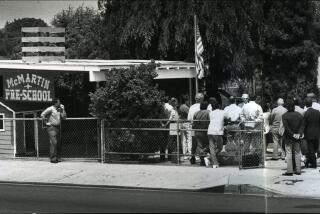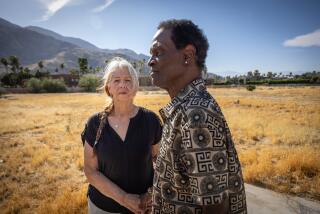Doctors Elicit Hints of Cult Children’s Life : Psychiatry: Therapists find youngsters released from Branch Davidian compound reticent and frightened, but a disturbing picture is emerging.
HOUSTON — Dr. Bruce Perry recalls the day when one of the little girls who had been released from the Branch Davidian compound in Waco was asked to draw a picture of her house.
At first, she drew a very normal looking structure--one with a roof and smoke coming from the chimney and a glorious, brightly hued rainbow overhead. When she was finished, Perry asked her if there was anything else. After pausing for a moment, she picked up her crayon and made dozens of dots in the roof.
“That was the bullets,” Perry said.
Perry, the chief of psychiatry at Texas Children’s Hospital here, was part of a team that went to Waco to look after the needs of the 21 children who left the cult compound in the week after the Feb. 28 battle that killed four Alcohol, Tobacco and Firearms agents and six cult members.
In a news conference Tuesday, Perry discussed a report he compiled for therapists and others looking after the children and described the oddities of life inside the walls of the compound, in which the traditional makeup of the family had been discarded for the pleasure and whims of one man.
He confirmed also what had long been suspected, that young girls, if not sexually abused, were exposed to inappropriate sexual ideas and possibly sexual misconduct by cult leader David Koresh, who perished in the fire that destroyed the compound.
And he told of frightened youngsters who felt more like hostages after they came out of the compound and who did their best to keep secret what life had been like inside it.
“Children really reflect the world they grow up in and that’s what we saw in these children,” said Perry. “We learned a lot about life inside the compound and a lot about David Koresh.”
A picture of that life, like the picture the little girl drew, is disturbing. In one section of the report about discipline within the compound, Perry told of how children expected to be hit with what they called “the helper” for infractions as minor as spilling a drink. “The helper” was variously described as a wooden paddle broken off from an oar or as a rice stirrer.
Perry also said that some of the girls released from the compound had circular lesions on their buttocks, probably a result of being hit. But he defended the state’s Children’s Protective Services, which twice went to the compound before the raid to investigate child abuse reports, but took no action.
“I think the concept of abuse can mean different things to different people,” he said. “CPS has legal issues it is forced to comply with about evidence. So I do think people need to understand that in that regard, it’s a difficult task sometimes.”
Among other things, Perry gave an example of how dominant Koresh was in the lives of the Branch Davidians, dictating every rule, making virtually every decision inside the compound.
He said that when several of the children were taken to the Methodist Home in Waco after they were released, they tried to immediately establish which person was the authority figure. “They wanted to know who made the rules,” he said.
In the world of the Branch Davidians, boys led rigorous lives, often up at 5:30 a.m. to go to the “gym,” where they marched and drilled in what seemed like paramilitary exercises. As soon as the boys reached the age of 12, they became apprentices to learn a trade. Older boys were not allowed in the female quarters and they were encouraged to engage in staged fights.
Girls, on the other hand, had something of a languid lifestyle, spending a great deal of their time napping and playing in small groups.
All the children, Perry said, seemed fascinated by such things as running water, flush toilets and warm food. Pork and chocolate were prohibited inside the compound and the report said some of the women were on diets of fruit and popcorn “to keep them thin.”
Perry said that getting children to talk about their education was difficult, but that much of it seemed to center on the Bible. He said it did not appear, for example, that the children were taught anything about history. He also said in the report that the songs they knew were disturbing in their content.
“A number of songs were taught to the children in the context of their school, Bible lessons and play,” Perry wrote. “These songs had a variety of themes but usually were filled with violent, warlike or apocalyptic imagery.”
Perry said that, in time, the children should recover from the trauma of the attack on the compound and subsequent siege. He speculated that as they are separated and become less suspicious, they would tell more of what life was like inside the compound.
But for now, he said, they remain secretive. For example, one of the youngsters once related how the children had been instructed to call their natural parents “dogs.” The older children “would come over and censor and not allow the topic to be discussed,” Perry said. “We had a very hard time getting beyond those initial comments.”
More to Read
Sign up for Essential California
The most important California stories and recommendations in your inbox every morning.
You may occasionally receive promotional content from the Los Angeles Times.










